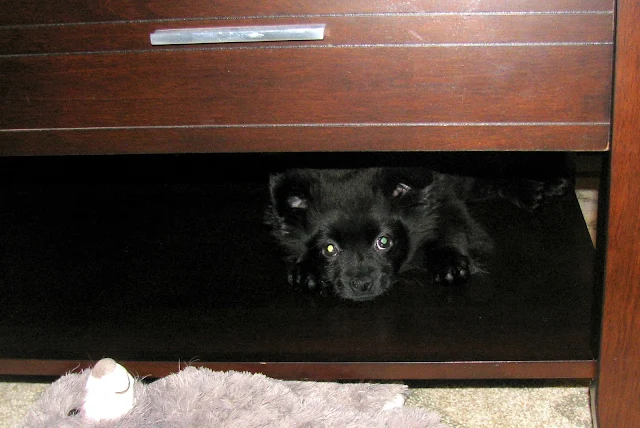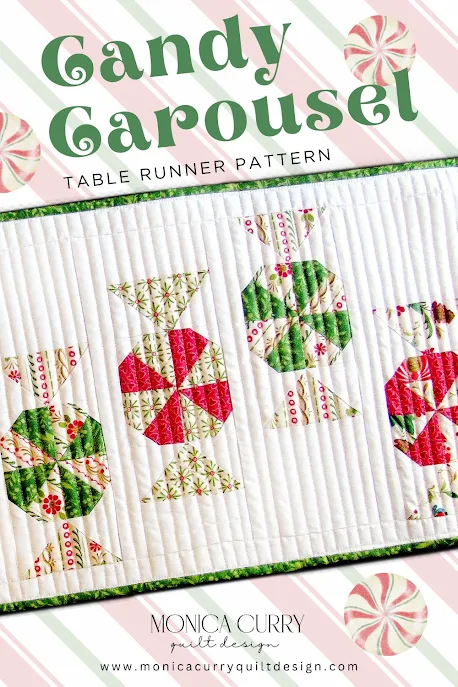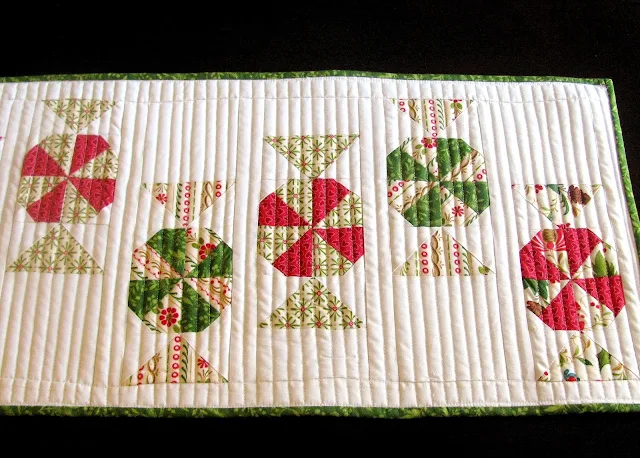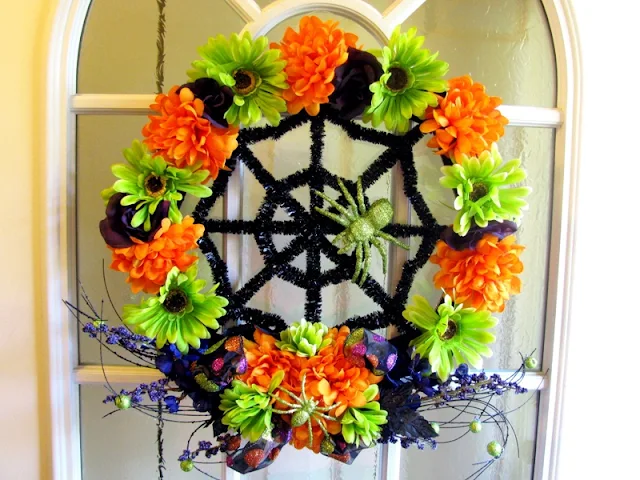Holiday Magic Wall Quilt Pattern
Talk about getting a pattern project finished under the wire. I really wanted to have the pattern launch done for my Holiday Magic wall quilt long before Christmas, but Christmas preparations and our new puppy took up most of my time. I love, love, love this pattern and I think you will too. It's made up of simple foundation piecing and fusible web applique. I think it would be stunning in any Christmas fabric. Anyone with basic applique and foundation piecing skills will have no trouble doing this up quickly.
Make Your Own Fat Quarter Boxes

Like most quilters, my fabric stash often fills up faster than I can store it, ending up with me not knowing what I have or what I don't have. Thankfully, I love organizing and having a place for everything and everything in its place.
I normally buy fat quarters and charm packs for my projects, so I needed a storage solution that would keep them nicely organized and in plain sight. After much experimenting, I came up with a box that's perfect for storing fat quarters and charm packs.
I normally buy fat quarters and charm packs for my projects, so I needed a storage solution that would keep them nicely organized and in plain sight. After much experimenting, I came up with a box that's perfect for storing fat quarters and charm packs.
YOU WILL NEED
- Download the Fat Quarter Storage Box template HERE
- Printer
- [1] 24"x 36" cardboard sheet, cut into two 24" x 18" sheets. (Cardboard sheets can be purchased at any art store).
- tape (I used masking tape)
- double-sided tape
- spray glue or large glue stick
- pencil
- utility knife
MAKING THE BOX TEMPLATE
1. Print the [4] four template pieces.

4. With spray glue or a glue stick, glue the assembled template to the first sheet of cardboard. (Fig 2)

5. With a utility knife, carefully cut out the template along the outer edges.




This isn't the prettiest box I admit, but it does the job. You could spray paint it, cover it with Mactac, or use nicer cardboard.
2. Cut along the inner edges of the template pieces.
3. Line up the pieces using the dots then tape together. Do not overlap. (Fig 1)
3. Line up the pieces using the dots then tape together. Do not overlap. (Fig 1)

4. With spray glue or a glue stick, glue the assembled template to the first sheet of cardboard. (Fig 2)

5. With a utility knife, carefully cut out the template along the outer edges.

HOW TO MAKE THE FAT QUARTER BOX
1. Pin the template to the second cardboard sheet; you maybe don't want to use your best pins for this. Trace the template and carefully cut out this piece with a utility knife.

2. Lightly score the cardboard on the dotted lines on the template.
3. Gently bend the box at the scored lines.
4. Using double-sided tape or glue, join the flaps to the outside of the box and add pressure to be sure the glue sticks.

3. Gently bend the box at the scored lines.
4. Using double-sided tape or glue, join the flaps to the outside of the box and add pressure to be sure the glue sticks.



Merry Christmas!
I hope you have a wonderful holiday season!
Candy Carousel Table Runner
My newest pattern, Candy Carousel, was inspired by Christmas peppermint candies. This table runner pattern is simple and modern. It would make an excellent project for the confident beginner. Pattern includes instructions for making quick pinwheel blocks.
How to Raise Your Cutting Table to Reduce Back Strain

HOW TO RAISE YOUR CUTTING TABLE TO REDUCE BACK STRAIN (Updated July 5, 2018)
When I worked as a graphic designer, I sat for long hours at the computer. It was easy to get lost in my work and not pay attention to my body. I paid the price, however, because this caused me to suffer from back pain for years. So, when I started quilting more, it became clear that I needed an ergonomically friendly cutting table. There were several options available to me, but I opted to buy the Linnmon/Finvard table from Ikea. This Ikea table height can be adjusted to several heights with a "peg-in-the-hole system." This table was a great buy, but there are other ways to get a raised table without putting out a lot of cash.
FIND THE CORRECT TABLE HEIGHT FOR YOU
Measure from the floor to about 6 inches below your elbow. This will give you the proper table height for your height.
TYPES OF RAISERS
1. FOLD-AWAY TABLE AND PVC PIPE
You can make most any fold-away table ergonomically friendly using PVC pipe. You can buy PVC pipe in the plumbing section of any hardware store. This project uses 1.5 inch PVC pipe.
FIND THE LENGTH TO CUT THE FOUR PVC PIPES
- Measure the original table height, e.g. 38 inches
- Now, measure the table leg from the joint to the floor, e.g. 20 inches
- Subtract the new table height needed from the original table height, e.g. 45" - 38" = 7 inches
- Add measurement B to measurement C, e.g. 20" + 7" = 27 inches
- Cut four PVC pipes 27 inches long.
- Slip the PVC pipes over the table leg as shown in Diagrams 1 & 2.
2. BED RISERS
The next option for raising your table is a bed riser. Bed risers can be purchased online or at a hardware or furniture store. Bed risers range in heights from approximately 3 inches to 8 inches.

3. WOOD SCREW-IN FINIAL
Lastly, if your table legs are wood, you can attach wooden screw-in finals to the bottom of them. Drill a hole into the bottom of the table leg the length of the end screw on the finial. Screw the finial into the leg. You could secure the finial with a little bit of very strong glue for extra support. Finials come in a variety of shapes and lengths.

My favourite foundation piecing papers
Anyone who has done foundation paper piecing (FPP) knows how frustrating and tedious it is when struggling with bad piecing paper. I've tried most every FPP on the market. I've also tried various tissue papers, tracing papers, parchment paper, copy papers, phone book paper ... well, you get the picture. After all my research, my favourite FPPs are Fun-dation and Sulky Tear Away Stabilizer.
Because I do a lot of FPP for my designs, I was excited to see Fun-dation brand piecing paper go on sale recently at Amazon.ca for $5 CDN. I ordered five packages. A package has 25 sheets. I'm glad I ordered when I did because the price went back up to $7.69 CDN (which is still not too bad). Fun-dation brand FPP is the best I've used. It tears away beautifully, it's translucent enough for fabric placement, and it prints well; I love this stuff. One package of Fun-dation works out to about 0.31 cents a sheet.
 |
| Fun-dation Foundation Piecing Paper |
Another very good option for FPP is Sulky Tear-Easy Stabilizer in the 12" x 11 yards roll ($15.11 CDN at Amazon). Sulky Tear-Easy is very much like Fun-dation. An 11-yard roll of Sulky makes [47] 8.5 inch wide sheets at 0.32 cents a sheet.
 |
| Sulky Tear-Easy Stabilizer |
How to Resize Quilt Blocks and Patterns


Quilt patterns can come in many sizes. But what if the size of the pattern isn't the size you want? Maybe you want a throw instead of a mini quilt or a baby quilt instead of a king-size. To resize your pattern or block, you need to know the percentage to reduce or enlarge the pattern templates. Read below to learn three easy ways to get the percentage you need to resize templates.
THREE METHODS FOR RESIZING YOUR QUILTS AND BLOCKS
1. DO THE MATH
Below is the very simple formula to get the percentage for reducing or enlarging.
ENLARGING:
Measure the shortest length of the original block size? e.g. 6 inches
What size do you want the new block to be? e.g. 8 inches
Divide the new size by the original size, e.g. 8 ÷ 6 = 1.33.
Move the decimal point two steps to the right to get your percentage = 133%.
Enter 133% into the copy machine to enlarge your 6-inch block to an 8-inch block.
REDUCING:
Do the opposite of above.
Divide the small size (e.g. 6") by the large size (e.g. 8") to get your reduction
percentage, e.g. 6 ÷ 8 = 0.75 = 75% reduction.

Do the opposite of above.
Divide the small size (e.g. 6") by the large size (e.g. 8") to get your reduction
percentage, e.g. 6 ÷ 8 = 0.75 = 75% reduction.
2. PROPORTIONAL SCALE
Proportional Scales may look a bit intimidating at first but they're easy to use.
You can buy a Proportional Scale for quilters HERE.

How To Use a Proportional Scale
Proportional Scales may look a bit intimidating at first but they're easy to use.
You can buy a Proportional Scale for quilters HERE.

How To Use a Proportional Scale
- On the bottom wheel, find the original size of your block (e.g. 6"), [Fig 1].
- Line up this number with the new size (e.g. 8") on the top wheel, [Fig 1].
- In the window, you'll see the percentage of the reduction or enlargement you need to resize your block, [Fig 2].
Note: The math formula and proportional scale results may be off a tiny bit. This is okay.

Figure 1

Figure 2
3. PROPORTIONAL MEASUREMENT CHART

Figure 1

Figure 2
3. PROPORTIONAL MEASUREMENT CHART
- Download my enlargement and reduction charts to find the percentages you need at a glance. Download PDF
- Find the original measurement on the left side of the chart.
- Go along that row until you get to the measurement you want on the top row.
- The number in the intersecting box is the percentage you'll need to reduce or enlarge your block

Halloween Decor 2017: Beautiful Halloween wreath
A couple of years ago I posted a Halloween floral arrangement that I made for my home. This year, I made a Halloween wreath for my front door. I turn 60 this October and I love Halloween, so I'm having a birthday/Halloween party for my big day. I wanted a pretty wreath on the door to greet my guests. I saw some beautiful wreaths on Pinterest with skulls and ghoulish stuff, but I wanted a floral wreath. Everything I used to make this wreath is from the dollar store. It cost about $15 to make which proves you don't need a lot of money to pretty up your home for Halloween. Happy Halloween one and all!
Halloween Witchy Boots
Halloween is almost here again. This is my favourite time of year. Costume parties, treats, tricks, and spooky stuff; I love it all. Today I'm launching my new Halloween pattern Witchy Boots for 2017. This mini quilt is a simple applique pattern that's perfect for a confident beginner. The finished size is 13" x 15" (32.5cm x 37.5cm).
The pattern was inspired by the image from the Wizard of Oz (1939) of the Wicked Witch of the East's boots after Dorothy's house crushes her. Dorothy had a whole mess of problems after that. My version looks the Wicked Witch of the East was stuffed in a trash can, but you get the idea.
Three DIY Pin Cushion Ideas with Tutorials and Free pattern

1. How to Make a Vintage Planter Pin Cushion
Pin cushions are an absolute necessity in any sewing studio. You usually don't realize this until you don't have one around when you need it. If you go online or on Pinterest, you'll see hundreds of different variations of a pin cushion. There was, however, one pin cushion I fell in love with. It's the vintage planter pin cushion.
I came across these little cuties at Lovely Little Handmaids and knew I had to make one. I picked up a vintage planter at the flower shop and, in no time, I made this adorable little pin cushion. See the instructions below to make your own. I think they would make great gifts for your sewing friends.
You can probably find one of these little planters at a thrift shop or rummage sale for a few cents. You may also want to check out your local florist shop to see if they have any kicking around from days gone by. That's where I found mine.
I came across these little cuties at Lovely Little Handmaids and knew I had to make one. I picked up a vintage planter at the flower shop and, in no time, I made this adorable little pin cushion. See the instructions below to make your own. I think they would make great gifts for your sewing friends.
INSTRUCTIONS
You can probably find one of these little planters at a thrift shop or rummage sale for a few cents. You may also want to check out your local florist shop to see if they have any kicking around from days gone by. That's where I found mine.
Step One
To give the pin cushion extra weight, glue pebbles to the bottom of the container with a glue gun.
Step Two
Measure the diameter of the opening of the container and cut a circular piece of fabric two inches larger than this measurement.
Step Three
With a strong thread, stitch around the edge of the fabric. Pull the thread to gather the fabric leaving an opening large enough to insert the filler.
Step Four
Stuff the fabric with lots of filler then tighten the thread and secure it with a knot.
Step Five
With a glue gun, apply hot glue around the inner edge of the container. Place the "fabric ball" into the container making sure it adheres to the glue.
2. How to Make a Juki 2010Q Wrap-Around Pin Cushion
I recently made this pin cushion for my new Juki 2010Q. I can't work unless this is wrapped around my machine. Don't you love the thread spools fabric? It's from the Cute As a Button fabric line by Delphine Cubitt. NOTE: This pattern can be customized to fit any sewing machine by adjusting the length of the end straps.

MATERIALS
- [2] 4" x 24" strips of fabric of your choice.
- [2] 1" pieces of hook and loop tape (Velcro®).
- Toy stuffing or leftover quilt batting.
Download pin cushion pattern HERE
INSTRUCTIONS
1. Layer the two fabrics and fold in half at the center.

3. With right sides facing, stitch a 1/4 inch seam from end to end as seen below. Leave the ends open, and leave a 3 inch opening on one side.


4. Turn stitched piece right side out and press.


5. Fold the piece in half vertically and place the template on it.
6. With a fabric marker or pencil, mark on the fabric the vertical lines on the template.
7. Stitch both vertical lines.

9. Fold in both ends 1/4 inch and stitch closed.
10. Stitch on the hook and loop tape at each end.
3. The Classic Mason Jar Pin Cushion
This is my go-to pin cushion for small mending jobs. The Mason jar (mine is a Gem jar) pin cushion is an all-time classic. You can find hundreds of these on Pinterest. There's that cute thread spool fabric again. Here's a great tutorial from The Seasoned Homemaker.
4. How to Make a Picture Frame Pin Cushion
Here is another pin cushion idea I used for my Pfaff machine. If you don't have any buttons on the front of your sewing machine, this pin cushion works great and looks ultra stylish.
INSTRUCTIONS
- Get a small pretty frame and remove the backing and glass.
- Cut a piece of thin cardboard the size of the backing.
- Cut a piece of fabric one inch larger than the cardboard piece.
- Glue some stuffing to the cardboard.
- Wrap and glue the fabric edges 3/4 of the way around the stuffing and the cardboard and let dry.
- Add more stuffing as needed and finish gluing fabric edges to the cardboard.
- Put the stuffed cardboard through the frame.
- Re-attach the frame backing to hold cushion in place.
- Use sticky-back Velcro® to adhere the finished pin cushion to the front of the sewing machine.
Little Puppy Placemat
Last week I launched my cute Kitty Cat placemat pattern. This week I'm introducing its partner, my new Little Puppy placemat. Both placemats are great for kids or grand-kids, but could also be used as hot pads in the kitchen. They are simple to make with basic fusible appliquè. This pattern is perfect for the confident beginner who wants to learn bias binding and fusible appliquè.
Subscribe to:
Posts (Atom)


.jpg)





.jpg)









.jpg)



.jpg)